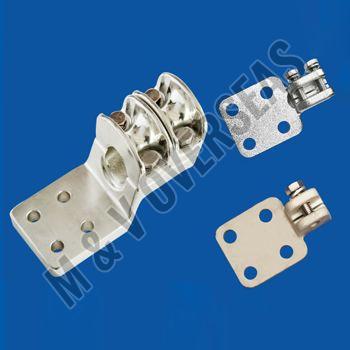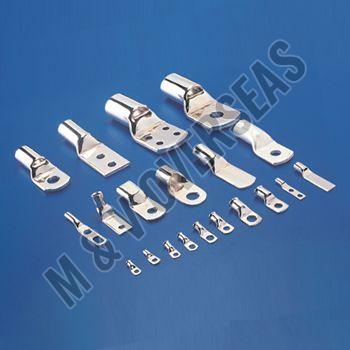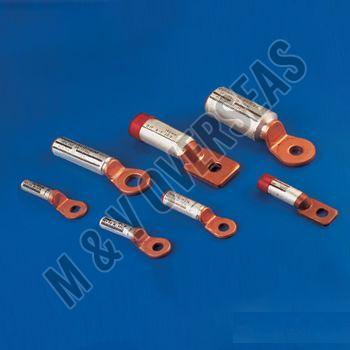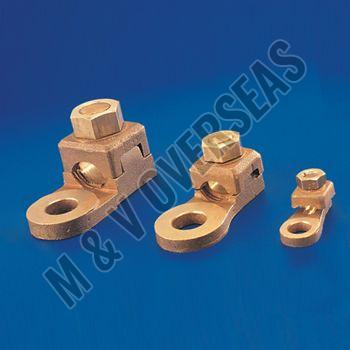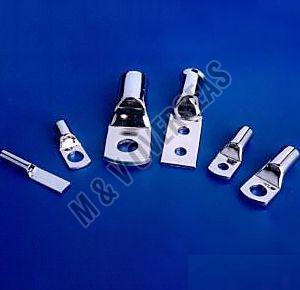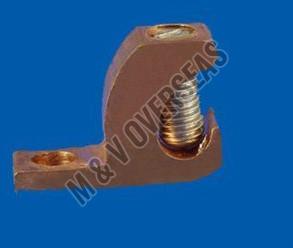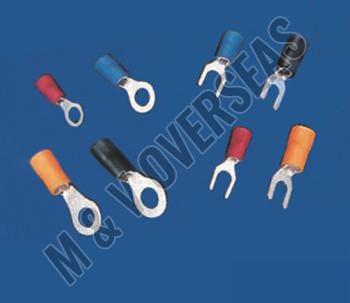View Mobile Number
Cable Lugs
Leading Manufacturers and Wholesaler of Aerial Cast Lugs, Aluminum Cable Terminal Lugs, Bi-Metallic Copper And Aluminium Terminal Lugs, Bronze Mechanical Bolted Lugs, Copper Cable Terminal Lugs, Copper Lay in Lug and Pre-Insulated Copper Terminal Lugs from Jamnagar.
| Business Type | Manufacturer, Supplier |
| Material | Aluminium |
| Finishing | Polished |
| Color | Silver |
| Application | Industrial |
| Feature | Durable, Casting Approved |
| Type | Cable Lugs |
| Country of Origin | India |
Aerial cast lugs serve the following functions
- Conductor Termination:They provide a means to terminate or connect power conductors to various devices or equipment, such as transformers, switches, or reclosers.
- Electrical Connectivity:Aerial cast lugs ensure a solid electrical connection between the conductor and the connected component, allowing for the efficient transfer of electrical current.
- Mechanical Support:These lugs help distribute the mechanical load and stresses experienced by the conductor to the connected equipment, ensuring stability and preventing damage.
Applications
- Transformer Lugs:These lugs are used to connect power conductors to the input or output terminals of transformers.
- Switch Lugs:Switch lugs provide a connection point for power conductors at switches or reclosers.
- Splice Lugs:Splice lugs are used to join two conductors together to create a continuous electrical path.
| Business Type | Manufacturer, Supplier |
| Material | Aluminium |
| Finishing | Polished |
| Color | Silver |
| Application | Electrical Ue |
| Size | Any Size |
| Feature | Casting Approved, Durable |
| Type | Aluminium Lugs |
| Country of Origin | India |
Key features and uses of Aluminium cable lugs terminals include:
- Material: Aluminium cable lugs are made from high-conductivity Aluminium to ensure efficient current flow and electrical performance.
- Cable Size: They come in various sizes to accommodate different Aluminium cable diameters and cross-sectional areas, allowing for a wide range of cable termination applications.
- Termination: Aluminium cable lugs are typically attached to the cable ends using compression or crimping methods, creating a reliable and permanent electrical connection.
- Applications: Aluminium cable lugs are used in various electrical systems, including power distribution, electrical panels, transformers, motors, and other electrical equipment.
- Corrosion Resistance: Aluminium lugs are naturally resistant to corrosion, making them suitable for outdoor and marine applications where exposure to moisture is a concern.
- High Current Capacity: Aluminium has good electrical conductivity, allowing for high current-carrying capacity, making it suitable for power distribution and heavy-duty applications.
- Lightweight: Aluminium cable lugs are lightweight compared to Copper lugs, making them easier to handle and install.
- Cost-Effective: Aluminium is generally less expensive than Copper, making Aluminium cable lugs a cost-effective option for certain applications.
| Business Type | Manufacturer, Supplier |
| Material | Aluminium, Copper |
| Color | Golden, Silver |
| Application | Electrical Fittings |
| Size | As Per Requirement |
| Feature | Durable, Non Breakable |
| Country of Origin | India |
Key features and uses of bi-metallic Copper and Aluminium terminals include:
- Material: Bi-metallic terminals consist of two main parts – a Copper portion and an Aluminium portion. The Copper portion is made from high-conductivity Copper, and the Aluminium portion is made from high-quality Aluminium.
- Transition Design: Bi-metallic terminals are designed to accommodate both Copper and Aluminium conductors. The two metals are metallurgically bonded or mechanically clamped together to ensure a reliable and low-resistance connection.
- Avoiding Galvanic Corrosion: When Copper and Aluminium come into direct contact without a proper transition, it can lead to galvanic corrosion due to the different electrochemical properties of the metals. Bi-metallic terminals help prevent this corrosion issue.
- Size: Bi-metallic terminals come in various sizes to accommodate different Copper and Aluminium cable diameters, allowing for a wide range of cable termination applications.
- Termination: They are typically attached to the cable ends using compression or crimping methods, creating a reliable and permanent electrical connection.
- Applications: Bi-metallic Copper and Aluminium terminals are used in various electrical systems where connections between Copper and Aluminium conductors are required, such as power distribution, electrical panels, and transformers.
- Electrical Safety: Bi-metallic terminals ensure a secure electrical connection while mitigating the risk of galvanic corrosion and maintaining electrical safety.
- Durability: The metallurgical bonding or mechanical clamping of Copper and Aluminium in the bi-metallic terminals provides durability and resistance to environmental factors.
| Business Type | Manufacturer, Supplier |
| Material | Bronze |
| Finishing | Polished |
| Color | Golden |
| Application | Cable Use |
| Feature | Casting Approved, Durable |
| Type | Cable Lugs |
| Country of Origin | India |
Key features and advantages of Brass mechanical bolted lugs include:
- Electrical Conductivity: Brass is a relatively good conductor of electricity, ensuring efficient power transfer through the lug and conductor.
- Corrosion Resistance: Brass lugs are designed to be corrosion-resistant, making them suitable for both indoor and outdoor applications.
- Mechanical Strength: Brass provides robust mechanical connections, ensuring long-lasting and reliable electrical connections.
- Versatility: Brass mechanical bolted lugs are available in various sizes and configurations to accommodate different conductor sizes and types.
- Temperature Resistance: Brass lugs can withstand high temperatures, making them suitable for applications with elevated ambient temperatures.
- Easy Installation: Brass bolted lugs are generally easy to install and require standard hand tools for connection.
Brass & Bronze mechanical bolted lugs are widely used in various electrical systems and installations, including:
- Connecting Copper power cables to circuit breakers or electrical panels.
- Joining Copper conductors in power distribution systems.
- Connecting electrical equipment and devices that use Copper conductors.
| Business Type | Manufacturer, Supplier |
| Material | Copper |
| Finishing | Nickel Plated |
| Color | Silver |
| Application | Electrical Ue |
| Size | As Per Requirement |
| Feature | Casting Approved, Durable |
| Type | Copper Terminal Lugs |
| Country of Origin | India |
Key features and uses of Copper cable lugs terminals include:
- Material: Copper cable lugs are made from high-quality, high-conductivity Copper to ensure low-resistance connections and efficient current flow.
- Cable Size: They come in various sizes to accommodate different cable diameters and cross-sectional areas, allowing for a wide range of cable termination applications.
- Termination: Copper cable lugs are typically attached to the cable ends using compression or crimping methods, which create a reliable and permanent electrical connection.
- Applications: Copper cable lugs are used in various electrical systems, including power distribution, electrical panels, transformers, motors, generators, and other electrical equipment.
- Types: Copper cable lugs come in various types, such as ring lugs, spade lugs, pin lugs, and butt splice lugs, to suit different termination needs.
- Electrical Safety: Properly installed Copper cable lugs contribute to the safety and reliability of electrical installations by providing secure connections and minimizing the risk of loose connections or electrical faults.
- Corrosion Resistance: Copper is naturally resistant to corrosion, making Copper cable lugs suitable for both indoor and outdoor applications.
- High Current Capacity: Copper’s high conductivity allows for high current-carrying capacity, making it suitable for power distribution and heavy-duty applications.
| Business Type | Manufacturer, Supplier |
| Material | Copper |
| Finishing | Polished |
| Application | Electrical Ue |
| Feature | Casting Approved, Durable |
| Type | Copper Lugs |
| Country of Origin | India |
Key Features
- Made from high-strength, pure electrolytic Copper for optimal performance
- UL467 Listed for direct burial in earth or concrete
- Open-faced design for fast and easy lay-in of conductors without cutting or breaking
- Accommodates #14 #4 copper wire
- Side entrance design for quick installation of continuous conductors to multiple locations
- Constructed from electrolytic Copper and AISI 304 Stainless Steel for durability
- Compliant with UL/CSA standards
Applications
- Grounding swimmi:ng pools
- Solar panel installations
| Business Type | Manufacturer, Supplier |
| Material | Copper |
| Finishing | Polished |
| Color | Multicolor |
| Application | Electrical Ue |
| Size | As per requirement |
| Feature | Casting Approved, Durable |
| Country of Origin | India |
Key features and uses of pre-insulated Copper terminals include:
- Material: Pre-insulated Copper terminals are made from high-conductivity Copper for efficient current flow and electrical performance.
- Insulating Sleeve: The pre-insulated terminals have an insulating sleeve made from materials like PVC or nylon that provides electrical insulation and protection from moisture, chemicals, and physical damage.
- Termination: They are typically used to terminate Copper cables and are attached using compression or crimping methods, ensuring a reliable and permanent electrical connection.
- Cable Size: Pre-insulated Copper terminals come in various sizes to accommodate different cable diameters, making them suitable for a wide range of cable termination applications.
- Applications: They are used in various electrical systems, including power distribution, control panels, electrical cabinets, and equipment wiring.
- Electrical Safety: Pre-insulated Copper terminals provide an added layer of electrical safety by insulating the connection, reducing the risk of accidental contact and electrical hazards.
- Convenience: The pre-insulated design eliminates the need for additional insulating materials or heat shrink tubing, saving installation time and labour.
- Durability: The insulating sleeves used in pre-insulated Copper terminals are durable and designed to withstand various environmental conditions.

